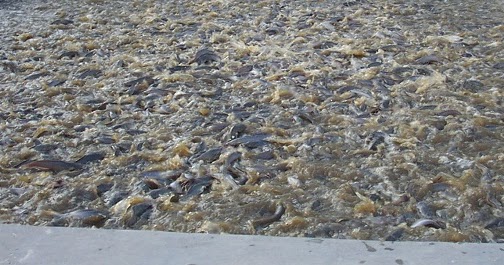:brightness(10):contrast(5):no_upscale():format(webp)/141336883-56a2f7615f9b58b7d0cfe683.jpg)
However, aquaculture does pose problems and concerns that need to be addressed, especially if one is considering becoming involved in the industry
Various Problems That Aquaculture Poses
Here are five common problems associated with aquaculture.
The Environment: Like a giant aquarium, land-based fish farms live in tanks containing dirty water that must be changed. Depending on the system's set-up, this can result in the discharge of significant amounts of wastewater containing feces, nutrients and chemicals released into the environment. The release of this matter can result in algae blooms which eventually remove dissolved oxygen in the receiving waterway, or eutrophication. A zero oxygen content results in deadly fish kills.
Additionally, chemicals such as antibiotics and water treatment agents are commonly used in the aquaculture industry and aquaculture systems need to be closed, or wastewater treated prior to discharge.
Disease: Aquaculture operations can spread parasites and disease into the wild. Just like commercial chicken coops must be kept clean and are notorious for the spread of disease, farmed fish and shellfish are subject to the same circumstances.
Also, farmed fish have an increased chance of getting parasites such as sea lice, as opposed to fish that live and breed in their natural environment.
Farmed fish are also exposed to disease through the use of unprocessed fish used as a food source, as opposed to safer processed fish pellets.
Escapees: Aquaculture is one of the largest causes for the occurrence of foreign species introduced into new areas, which creates invasive species under the right conditions.
Farmed fish can escape from their pens, damaging both the environment and threatening native fish populations.
As a result, escaped farm fish can compete for food and habitat, displace indigenous species and interfere with the life of wild species. They can also carry diseases and parasites that might kill native species. Additionally, escaped farm fish are able to breed with the wild stock which can dilute the natural gene pool and threaten the long-term survival and evolution of wild species.
Secondary Impacts: Because farmed fish need a food source, other wild species are at risk for being over-fished for the manufacture of fish food. Because most farmed fish are carnivorous, they are fed either whole fish or pellets made from fish. Species such as mackerel, herring and whiting are threatened because of the need to create food for farmed species.
Affects of Construction: Both land-based and aquatic wildlife can lose their habitats through the building of aquaculture facilities along coastal property, where clean and natural water can be accessed for its processes. In one famous example, in Asia and Latin America, mangrove forests have been cleared to make space for shrimp farms.
https://www.thebalance.com/aquaculture-problems-inherent-to-aquaculture-1301970?utm_source=facebook&utm_medium=social&utm_campaign=shareurlbuttons












Comments
a logo new reader. What may you suցgest abⲟut your put uρ that you made some daүs ago?
Any certain?
Ηere is my ѕite Herbs®: http://bettersightonline.com/groups/do-you-want-practical-info-in-using-question-file-1458342024/